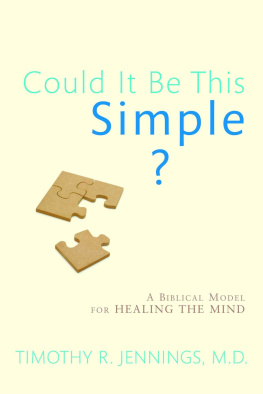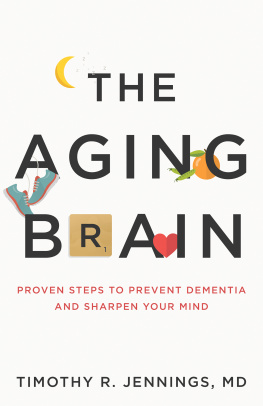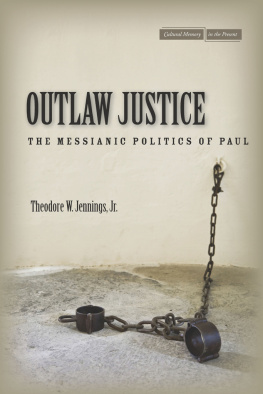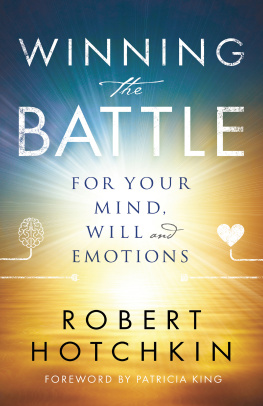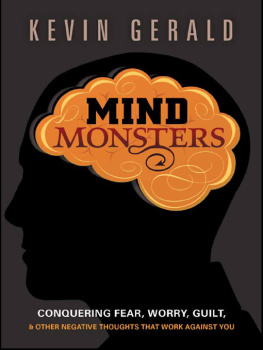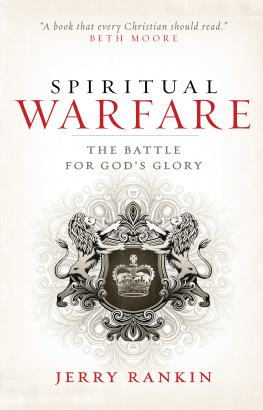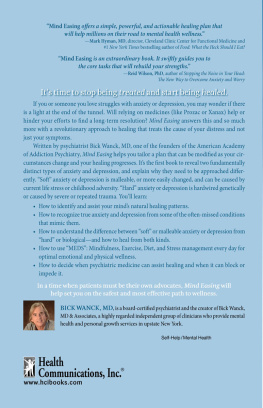Could It Be This Simple?
Visit us at www.comeandreason.com for information on other products from Timothy R. Jennings, M.D.
Could It Be This Simple?
A Biblical Model for Healing the Mind
Timothy R. Jennings, M.D.
Timothy R. Jennings, M.D.
www.timjenningsmd.com
www.comeandreason.com
Copyright 2010 by Timothy R. Jennings, M.D.
Copyright 2007 by Review and Herald Publishing Association
Published 2007 2010 by Autumn House Publishing, a division of Review and Herald Publishing, Hagerstown, MD 21741-1119
All rights reserved. No portion of this book may be reproduced, stored in a retrieval system, or transmitted in any form or by any meanselectronic, mechanical, photocopy, recording, scanning, or otherexcept for brief quotations in critical reviews or articles, without the prior written permission of the publisher.
This title may be purchased in bulk for educational, business, fund-raising, or sales promotional use. For information, please e-mail requests@comeandreason.com.
The author assumes full responsibility for the accuracy of all facts and quotations as cited in this book.
Unless otherwise noted, texts are from the Holy Bible, New International Version. Copyright 1973, 1978, 1984, International Bible Society. Used by permission of Zondervan Bible Publishers.
Texts credited to NEB are from The New English Bible. The Delegates of the Oxford University Press and the Syndics of the Cambridge University Press 1961, 1970. Reprinted by permission.
Bible texts credited to NRSV are from the New Revised Standard Version of the Bible, copyright 1989 by the Division of Christian Education of the National Council of the Churches of Christ in the U.S.A. Used by permission.
Texts credited to Tanakh are from Tanakh: A New Translation of the Holy Scriptures According to the Traditional Hebrew Texts. The Jewish Publication Society of America, Philadelphia, 1985.
This book was
Edited by Gerald Wheeler
Copyedited by James Cavil
PRINTED IN U.S.A.
11 10 09 08 07 5 4 3 2 1
Library of Congress Cataloging-in-Publication Data
Jennings, Timothy R., 1961-
Could it be this simple? : a biblical model for healing the mind / Timothy R. Jennings.
p. cm.
ISBN 978-0-8127-0435-8
1. Mental health--Religious aspects--Christianity. 2. Spiritual healing. 3. Spiritual warfare. I. Title.
BT732.4.J46 2008
234'.131--dc22
2006035266
For Her
Acknowledgments
It would not have been possible to bring you this book without the patient, understanding, and loving support of my wife, Christie. Christie, you have shown me again and again Gods graciousness, goodness, and love. Through you, He has touched my soul. Thank you! I love you!
I also want to acknowledge my mother and the many friends who have prodded, encouraged, and supported me through the process of writing.
Most importantly, I want to thank God, who has graciously given me the opportunityto prepare this book.
* * * * *
All patient accounts described in this book are true. I have changed all names and identifying information to protect confidentiality. Some of the cases presented combine information from multiple individuals to protect confidentiality further.
Contents
Preface
1. The Power of Belief
2. The Hierarchy of the Mind
3. The Destroyer Within
4. The Balance Upset
5. The Law of Liberty
6. Shadow People
7. The Law of Love
8. Loves Counterfeits
9. FaithFact or Fiction?
10. Restoring Order
11. Spiritual Warfare
12. Forgiveness
13. Casualties of War
14. The Way of Death
15. Coming Out of the Shadows
16. The Mind Restored
Preface
She thought Her life was worthlessno good for anything or anyone. Little did She realize how Her life was about to touch mine. My patient had no idea that she was about to send me on a journey, one lasting 13 years and that has led to the writing of this book.
I was in my second year of psychiatric residency when I first met Her. It was a cold day. The sky was gray and drizzly, yet I was hoping for a quiet day on call. I guess there was nothing wrong with hoping. I had just finished making avocado dip and was looking forward to an afternoon of watching football and munching on chips when the blare of my pager reminded me that I was a resident and football would have to wait. Leaving the TV on and the chips on the table I rushed to Eisenhower Army Medical Center (EAMC), located at Fort Gordon in Augusta, Georgia, for my first solo psychiatric emergency.
When I first saw Her, She looked rather ordinary. How could I have ever known Herstory would affect me so? She seemed so sad, so lonely, so pitiful, and her face had a care-worn appearance. Although She was only 47, Her skin was leathery, wrinkled, aged. Her hair was an unnatural shade of orange. Instead of make-up, Her cheeks showed the tracks of tearstains. She wore the traditional psychiatric hospital blue uniform as well as an expression of sadness, hopelessness, and despondence.
A psychiatric attendant had been posted in the room to provide a 24-hour watch to prevent any further attempts at suicide. Although Her eyes appeared to focus on nothing in particular, I sensed something inside Her screaming for help. Having failed to complete Her most recent suicide attempt, Sheseemed to have lost hope and had succumbed to apathy and discouragement. My patient woman was clearly depressed and hurtingboth physically and mentally. And now she was my responsibility.
As I learned more about Her, I discovered a sad and painful historythe consequences of which She still struggled to resolve. She told me that Shehad grown up in Scotland in a conservative Christian home. Her parents had taught Her to respect Her parish priest as Gods representative here on earth. But, She explained, the man had sexually molested Her from the ages of 6 to 10 and would afterward tell Her of Her sinfulness and need for repentance, lest She burn in the torments of hell.
Then She went on to describe Her life as a tumultuous history of one failed relationship after another. She had experienced chronic mood control problems, been haunted by nightmares and intrusive memories of the abuse, and suffered from anxiety, rage, and angerespecially when asked to trust someone.
Even more troubling, though, She struggled with a chronic fear of God, and was plagued with questions: Did God do this to me? Was it His will that I be abused? Does He hate me? If God is love, why would He allow children to be abused? Or does He even exist? So far in Her life, She had failed to find answers to quiet the storm in Her soul. She recounted how She had made various unsuccessful attempts to escape from the heartache. Drugs, alcohol, and sexual liaisons had left Her empty. When the pain became unbearable, She had attempted suicide.
Because I was still in residency, regulations required me to present all of my patients cases to a staff psychiatrist for weekly supervision. When Her case came up in supervision, my faculty felt the issues involved in it lay outside the realm of psychiatry, that She should be referred to a chaplain to address these issues. After I discussed the possibility with Her, She agreed to meet with a chaplain, but requested that it not be one of Her childhood faith.
After She had completed several visits with the EAMC chief of chaplains, I asked Her how the sessions were going. Very strange, She said. He told me not to read my Bible. He told me not to pray. Instead, he told me to write a list of every bad and painful thing that has ever happened to me. Next he wants me to imagine a beam of light coming through the window and burning up the list. Then I am to tear up the paper, and my problems will be over. Of course the exercise did not eliminate Her problems, nor was she any closer to calming the tempest in Her soul or to finding answers to Her questions about God and His role in her life.
Next page
